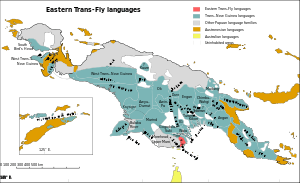Eastern Trans-Fly languages
| Eastern Trans-Fly | |
|---|---|
| Oriomo Plateau | |
| Geographic distribution | Papua New Guinea, Torres Strait Islands (Australia) |
| Linguistic classification |
Trans-Fly
|
| Glottolog | east2503[1] |
 Map: The Eastern Trans-Fly languages of New Guinea
The Eastern Trans-Fly languages
Trans–New Guinea languages
Other Papuan languages
Austronesian languages
Australian languages
Uninhabited | |
The Eastern Trans-Fly languages are a small independent family of Papuan languages in the classification of Malcolm Ross, that constituted a branch of Stephen Wurm's 1970 Trans-Fly proposal, which he later incorporated into his 1975 expansion of the Trans–New Guinea family as part of a Trans-Fly – Bulaka River branch.
Classification
Wurm himself concluded that some of his purported Trans-Fly languages were not in the Trans–New Guinea family but rather heavily influenced by Trans–New Guinea languages. Ross (2005) removed the bulk of the languages, including Eastern Trans-Fly, from Wurm's Trans–New Guinea.
Timothy Usher links the four languages here, which he calls Oriomo Plateau, to the Pahoturi languages and the Tabo language in an expanded Eastern Trans-Fly family.
Languages
- Eastern Trans-Fly
Pronouns
The pronouns Ross reconstructs for proto–Eastern Trans-Fly are,
I *ka exclusive we *ki inclusive we *mi thou *ma you *we he/she/it *tabV; e they *tepi
There is a possibility of a connection here to Trans–New Guinea. If the inclusive pronoun is historically a second-person form, then there would appear to be i-ablaut for the plural: *ka~ki, **ma~mi, **tapa~tapi. This is similar to the ablaut reconstructed for TNG (*na~ni, *ga~gi). Although the pronouns themselves are dissimilar, ablaut is not likely to be borrowed. On the other hand, there is some formal resemblance to Austronesian pronouns (*(a)ku I, *(ka)mu you, *kita we inc., *(ka)mi we exc., *ia he/she/it; some archeological, cultural and linguistic evidence of Austronesian contact and settlement in the area exists (David et al., 2011; McNiven et al., 2011; McNiven et al., 2006; McNiven et al., 2004: 67-68; Mitchell 1995).
References
- ↑ Hammarström, Harald; Forkel, Robert; Haspelmath, Martin, eds. (2017). "Eastern Trans-Fly". Glottolog 3.0. Jena, Germany: Max Planck Institute for the Science of Human History.
- Ross, Malcolm (2005). "Pronouns as a preliminary diagnostic for grouping Papuan languages". In Andrew Pawley; Robert Attenborough; Robin Hide; Jack Golson. Papuan pasts: cultural, linguistic and biological histories of Papuan-speaking peoples. Canberra: Pacific Linguistics. pp. 15&ndash, 66. ISBN 0858835622. OCLC 67292782.
DAVID, B., MCNIVEN, I.J., MITCHELL, R., ORR, M., HABERLE, S., BRADY, L. & CROUCH, J. 2004. Badu 15 and the Papuan-Austronesian settlement of Torres Strait. Archeology in Oceania 39(2): 65-78.
MCNIVEN, I.J., DICKINSON, W.R., DAVID, B., WEISLER, M., VON GNIELINSKI, F., CARTER, M., & ZOPPI, U. 2006. Mask Cave: red-slipped pottery and the Australian-Papuan settlement of Zenadh Kes (Torres Strait). Archaeology in Oceania 41(2): 49-81.
MCNIVEN, I.J., DAVID, B., RICHARDS, T., APLIN, K., ASMUSSEN, B., MIALANES, J., LEAVESLEY, M., FAULKNER, P., ULM, S. 2011 New directions in human colonisation of the Pacific: Lapita settlement of south coast New Guinea. Australian Archaeology 72:1-6.
MITCHELL, R. 1995. Linguistic Archeology in Torres Strait. Unpublished MA thesis (James Cook University: Townsville).